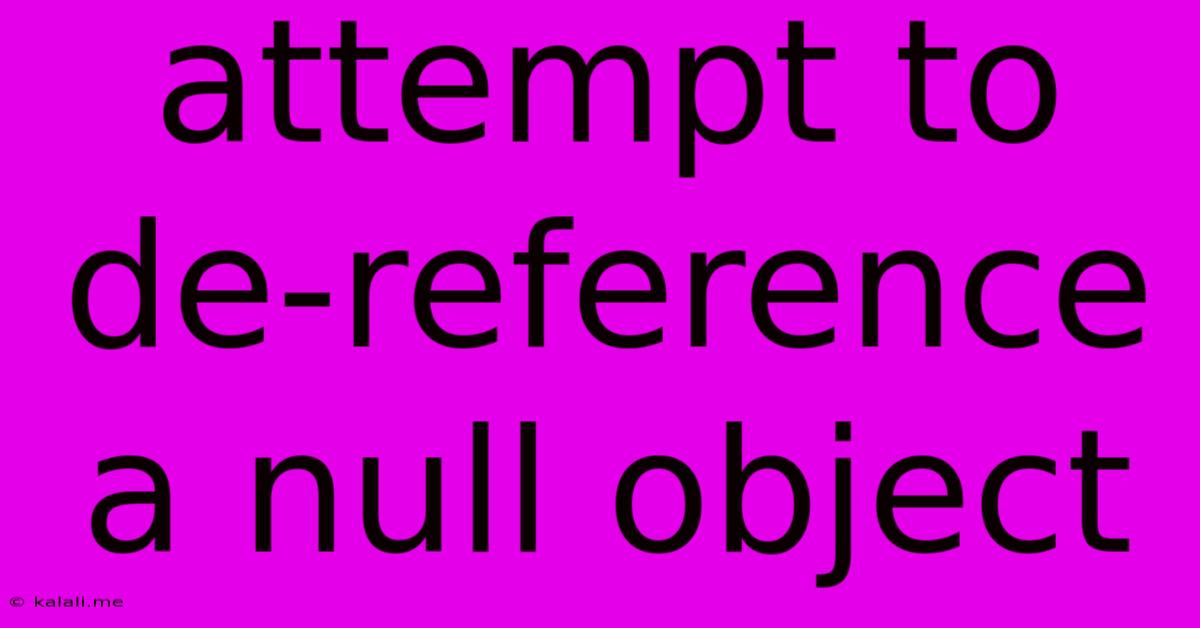Attempt To De-reference A Null Object
Kalali
May 30, 2025 · 3 min read

Table of Contents
Attempting to De-reference a Null Object: A Programmer's Nightmare and How to Avoid It
The dreaded "NullPointerException," or NPE, is a common programming error that plagues developers across various languages. This error, often abbreviated as NullPointerException in Java or System.NullReferenceException in C#, occurs when your program attempts to access a member (method or property) of an object that currently holds a null value – essentially, trying to interact with something that doesn't exist. This article will delve into the causes, consequences, and most importantly, effective strategies for preventing this frustrating and often insidious bug.
Understanding the Root Cause: The Null Value
A null value signifies the absence of an object. Think of it as an empty container – there's nothing inside to use. This state often arises from several scenarios:
- Uninitialized variables: Variables declared but not assigned a value are often implicitly null.
- Method returns: Functions or methods might return null to indicate failure or the absence of a result.
- Database queries: Database interactions might return null if a record isn't found.
- External data sources: Data fetched from external APIs or files could be null if the data is unavailable or malformed.
The Devastating Effects of a NullPointerException
When your program encounters a null object and attempts to access its members, the runtime environment throws a NullPointerException. The consequences can range from minor inconveniences to catastrophic system failures:
- Program crashes: The most immediate and obvious consequence is a sudden halt in program execution, resulting in a frustrating user experience and potential data loss.
- Unexpected behavior: In less severe cases, the NPE might not crash the program but lead to unpredictable behavior, making debugging a nightmare.
- Security vulnerabilities: Unhandled null pointer exceptions can create security vulnerabilities, especially if the error occurs in a critical section of code.
Proactive Strategies for Preventing NullPointerExceptions
Prevention is far better than cure when it comes to NullPointerExceptions. Here are some practical techniques to minimize their occurrence:
1. Careful Initialization:
Always initialize variables before using them. Avoid relying on implicit default values, especially in situations where null is not a valid state. Explicit initialization prevents accidental null dereferences.
2. Defensive Programming Techniques:
Employ defensive programming practices to handle the possibility of null values gracefully. This involves checking for null values before attempting to access members:
- Null checks: Use
if (object != null)statements to verify that the object isn't null before proceeding. - Optional chaining (where available): Languages like Kotlin and Swift provide optional chaining operators (
?.) that allow you to safely access members of potentially null objects without explicitly checking for null. If the object is null, the expression short-circuits and returns null. - Null-coalescing operator (where available): Operators like
??(in C#) or?:(in Java) provide a way to provide a default value if the object is null.
3. Robust Error Handling:
Implement robust error handling mechanisms to catch and gracefully handle potential NullPointerExceptions. Instead of letting the exception crash your program, handle it appropriately:
- Try-catch blocks: Wrap potentially problematic code sections in
try-catchblocks to catch the exception and prevent program termination. - Logging: Log the error details to aid in debugging and post-mortem analysis.
4. Design Choices:
- Immutability: Using immutable objects reduces the risk of accidental null assignment.
- Null Object Pattern: This design pattern provides a substitute object (the "null object") that behaves like a regular object but doesn't perform any significant actions. This avoids the need for explicit null checks in many cases.
By understanding the causes and consequences of null pointer exceptions and implementing the preventive measures outlined above, developers can significantly reduce the occurrence of this common programming error and write more robust and reliable applications. Remember, proactive coding practices are your best defense against the dreaded NullPointerException.
Latest Posts
Latest Posts
-
My Family And I Or Me
May 31, 2025
-
Only Instrument That Reads Alto Clef
May 31, 2025
-
How Many Different Combinations Of 3 Numbers
May 31, 2025
-
How To Feed A Minecraft Horse
May 31, 2025
-
How To Email Your Boss About A Family Crisis
May 31, 2025
Related Post
Thank you for visiting our website which covers about Attempt To De-reference A Null Object . We hope the information provided has been useful to you. Feel free to contact us if you have any questions or need further assistance. See you next time and don't miss to bookmark.